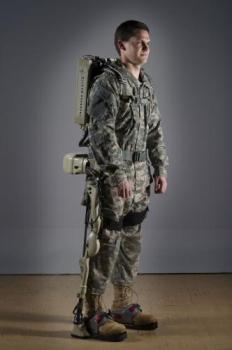The robotic exoskeleton, named HULC, from Lockheed Martin is currently undergoing Biomechanical testing at the Development and Engineering Center in Natick being conducted by the U.S Army.
 Lockheed Martin's HULC Begins Biomechanical Testing at U.S. Army Natick Soldier Systems Center.
Lockheed Martin's HULC Begins Biomechanical Testing at U.S. Army Natick Soldier Systems Center.
The feedback received from the soldiers would help in shaping further requirements of the HULC. Biomechanical testing would determine the changes in the energy levels spent by the users and how easily and quickly users adapt to the system. The warfighters would be first evaluated by determining the effects of carrying load without using the exoskeleton, for a period of seven weeks. The testing would also asses the metabolic efficiency by comparing the levels of oxygen consumed per unit total mass when the user wears the HULC and the level when he does not wear it, by maintaining other conditions such as load, grade, speed and duration of the same.
The HULC is a hydraulic-actuated anthropomorphic, battery powered un-tethered exoskeleton, which helps the user in carrying loads up to 200 lbs for 20 km on a single charge of the battery irrespective of the terrain. It is designed in such a way that it can withstand crawling, deep squats and lifting the upper body with minimum exertion. A micro-controller fitted inside it syncs its movement with that of the user. The Department of Veterans Affairs reported that musculoskeletal injuries were the most common type of injuries that the soldiers were inflicted with during their service period. A soldier wearing the HULC is protected from injury.
After the biomechanical testing is completed successfully, the HULC would be tested on field excursions in order to determine its performance in simulated operational environments. Lockheed Martin is looking at extending exoskeletons for industrial, medical and other military missions.